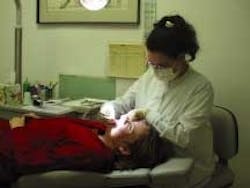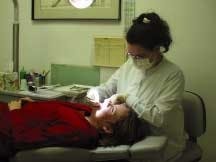Orthodontic Overhaul
Dental hygiene almost lost Jody Kohl of Stratford, Conn., to another profession. While majoring in special education at the University of New Haven, Kohl decided she wanted to do something different. Hearing about the university's new dental-hygiene program and knowing she was attracted to the health-care field, she decided to investigate. After all, she always looked at others' teeth, and she had become familiar with dental offices when she and her mother had worked together cleaning a dentist's office. She decided to make the change and later became a member of the university's first graduating class in 1995.
But after working only two years as a chairside hygienist for a pedodontist, she realized that she was "burning out." There just wasn't enough variety and the schedule was too predictable.
That's when fate struck and Kohl found her true calling. She answered a newspaper ad placed by an orthodontist who was seeking a hygienist. Dr. Thomas Braun of Fairfield, Conn., had realized that, as his practice grew, his time was shrinking. He began to recognize that many orthodontic procedures were simple and repetitive tasks that could be broken down into smaller steps and performed by a hygienist.
Kohl has found her calling. Her days are busy but she said the time flies because of the variety and scope of the skills she uses. "The braces are put on in the morning. It usually takes about 90 minutes and every day is a busy day," Kohl said. "I'm involved in the treatment plan from the very beginning."
A patient's first visit is a consultation with the dentist, then his or her chart will be compiled, starting with a panoramic X-ray and a cephalometric X-ray which will show the position of the jaws and the patient's biting pattern. Kohl takes both X-rays, then readies the trays for taking impressions of the patient's dentition so the study models can be made. She uses a digital camera to take photos of the patient - five intraoral shots, three pictures of the face (frontal, smiling, and normal), and a profile shot. Kohl then loads the data in the computer and prints the pictures. She uses the Quick Ceph Image program, which she learned on-the-job.
Spacers - "little rubber elastic rings placed between the 6-year-old molars to prepare the mouth for the bands," Kohl said - are applied after the records are created but before the braces are put on.
"When a patient first comes in for braces, I remove the spaces and perform a prophy, which is basically a quick polish," Kohl explained. "The teeth have to be smooth and clean so the brackets can adhere properly. Because the bands must sit subgingivally, the doctor will then place the bands on the 6-year-old molars. After he cements the bands in place, I remove the excess cement from the bands."
Kohl then begins bonding the brackets on to the teeth. Each tooth will be etched with acid etch - the same material used to apply sealants. She will dry the tooth and apply a light-cure primer, then places the brackets using a glue-like, light-cure cement. After the doctor has positioned each bracket, Kohl returns and, donning her orange protective safety glasses, uses an argon curing laser to complete the bonding. She will then use pliers to bend the wires into position and attach them to the brackets with ligature ties.
She particularly enjoys working as an orthodontic hygienist because she can work independently. Dr. Braun, who provides a comprehensive benefits package, eased Kohl into the position as he evaluated whether his idea to employ a hygienist made sense for the practice.
"I began working one day a week and continued to work at the pediatric practice. My hours with Dr. Braun continued to increase to its current schedule of six days and about 35 hours a week," Kohl said. "To me, this position is much more interesting than working in a general practice. I do something different with each patient."
At first glance, the appointment schedule appears formidable, but Jody explained that appointment times vary depending on the patient's needs. Sometimes an appointment only takes five minutes to do the necessary procedure, while others may take 45 minutes.
The patients in the practice range from 7 to 70 years old, but most are teenagers. While she is enthusiastic about all patients, she said kids are more fun because "the adults are fussier and they're looking for perfection. The kids just want to know when the braces are coming off."
She said the doctor uses "lots of expanders," which are necessary if the palate is too narrow when compared to the lower jaw. Expanders are cemented onto the molars across the palate and kept in place for six to nine months. Kohl sets up the records, but is unable to cement the expanders.
As Dr. Braun begins to move toward more lingual braces, Kohl will be learning more and expanding her scope of skills. One of her current skills is changing the ligatures - the little, rubber, colored elastic rings.
"They get dirty and lose their elasticity. That's a quick visit for the patient who gets to choose the color combination," Kohl said. "The patient comes in once every one or two months. As the teeth begin to align, the wires and ligatures are changed."
Initially, a thin flexible wire is used. As the treatment proceeds, progressively thicker wires are applied. Some patients have to come in for "repairs" more often than others because they may break their brackets, especially if they chew their pens or bite their nails. She uses fluoride-containing cement and always stresses the importance of good oral hygiene and a clean mouth.
One of her most memorable cases was the 16-year-old boy who had extreme Class III malocclusion. After wearing braces for about a year, he had major oral surgery performed to correct his jaw. The braces were removed after the surgery, and Kohl said the transformation in his personality and self-confidence was incredible. "He's like a new person. He's lost a lot of weight and now girls are calling him all the time and driving his mom crazy," Kohl said.
Dr. Braun's practice is unusual because he is one of the few orthodontists in the area who accepts Medicaid patients. The practice, therefore, includes patients from across the socioeconomic and ethnic spectrums. The secretary is bilingual so she can communicate with Hispanic parents about their children's treatment. She has noticed that more patients with Brazilian origins are coming to the practice, and Kohl has picked up some Spanish through her work.
She hopes that more orthodontists realize the contributions a hygienist can make to an orthodontic practice. She has been working with Dr. Braun for three years now and can't see herself doing anything else in the foreseeable future.
Judith Sulik, RDH, is a frequent contributor to RDH who is based in Bridgeport, Conn. She also is the author of An Adventure for Your Palate II: Coastal Connecticut Waterfront Dining with Chefs' Recipes. For more information about the book, contact her at Finely Finished Press, 60 Acton Road, Bridgeport, CT 06606.

